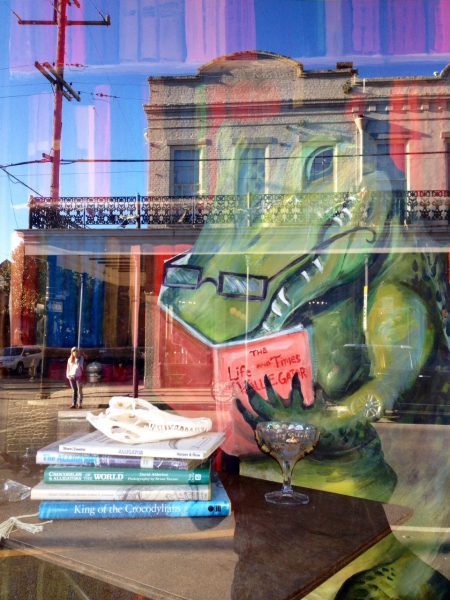In your carnival sideshow, you make the fear about smallness rather than the more predictable largeness. Leslie Fiedler’s Freaks pinpoints size as an important component in scaring someone. Did you consider choosing something more frightening?
My goal was to capture the horror of something so small and seemingly mundane in a world that’s meant to be larger-than-life. Every fair experience I’ve had has been filled with over-the-top excess: overwhelming lights and sounds, prize-winning giant vegetables, and pie eating contests. I wanted to examine the strangeness of something so quiet and relatively understated in this world of lights and noise. I experienced something similar as a child, and I remember expecting some overblown production with loud announcers and a giant stage. Something about the quiet walkthrough unnerved me, and I wanted to capture that immense shock brought on by something truly understated and un-hyped, like walking through an exhibit to see the World’s Smallest Woman. I think many people like oversized things; we are delighted by outrageously large housecats. We laugh at and applaud foods blown up to epic size, like a hamburger that feeds hundreds of people. On the other hand, we also are fascinated by miniatures: hamsters eating tiny burritos online or microscopic models made to fit in tiny glass bottles. But somehow, when a human lands on either end of that size spectrum, it becomes frightening, unnerving. For two young characters, I couldn’t think of anything more frightening than a real woman who was smaller than they ever could have imagined, especially after the disappointment (and relief) of a fake snake woman. The expectation that things will be fake is so comforting until that is taken away by real life terror.
The phrase “like my favorite crayon—a burnt red, a clay brown” makes it clear how young the kids are here. Likewise the phrase “the taste of sour funnel cake on my tongue” brings the carnival to life. Do you feel flash fiction has to use shorthand cues like this to locate the story?
I was initially drawn to flash fiction because of the immediacy of the form. There’s no room for a detailed, lengthy backstory, and the story relies on the urgency of detail to make up for what an author can’t spend time unpacking for a reader. Writing flash fiction requires me to ponder every word and consider when I need to be indirect, like shorthand details, and when I just need to tell the reader what she should know about a character or situation. I’ve spent most of my academic and professional life writing poetry, and flash fiction allows me to expand where poetry cannot, while still maintaining the efficiency of language that poetry often requires.
The story ends with the two kids feeling like the “freaks” in the tent. Is that what you are getting at? That we become freaks when we participate in stigmatizing others with our gaze?
Absolutely. How can they not be the freaks when they just paid to enter this exhibit? The circumstances are flipped once the children enter the tent. They realize the absurdity and ugliness of turning another human into a specimen at which to gawk. In that same experience, they feel the strange weight of someone staring back at them. The experiment can go both ways; they enter to see this unusual woman and to stare at her, but she stares back at them.
What do you see as the greatest strength and the greatest deficit in flash fiction?
I think the greatest strength is that you can jump into a scene without unraveling some elaborate backstory or character history. This lack of backstory is also the greatest deficit in flash fiction. It’s a balancing game—determining what needs to be in the story and what needs to be cut. Writing flash is a great way to hone revision skills; when every word matters, it makes me reevaluate every word, every extra detail that may or may not matter. Ultimately, the immediacy is what draws me to flash fiction. The characters and their circumstances have to matter from the first line.
What writers are particularly adept at handling short shorts, as they used to be called? What are a few of your favorite stories?
I love the book Flash Fiction Forward edited by James Thomas and Robert Shapard. I use it in my creative writing classes. It is filled with powerful, brief stories that play with point of view, like Stace Budzko’s story, “How to Set a House on Fire,” using second-person to guide a reader through the act of burning down a family estate. It reveals so much backstory so quickly, so seamlessly and without taking up room in the story. “Level” by Keith Scribner is another one I love, particularly because of the way he uses two characters and a simple household tool to unpack an entire marriage in very few words.



 The core workshop of SmokeLong Fitness is all in writing, so you can take part from anywhere at anytime. We are excited about creating a supportive, consistent and structured environment for flash writers to work on their craft in a community. We are thrilled and proud to say that our workshop participants have won, placed, or been listed in every major flash competition. Community works.
The core workshop of SmokeLong Fitness is all in writing, so you can take part from anywhere at anytime. We are excited about creating a supportive, consistent and structured environment for flash writers to work on their craft in a community. We are thrilled and proud to say that our workshop participants have won, placed, or been listed in every major flash competition. Community works.